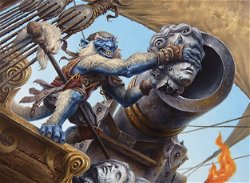With the banning of Deadly Dispute, Affinity decks need to readapt to the new Pauper after losing their main value and manafixing engine. Of the current lists, most have been betting on a 

On the other hand, Prophetic Prism was unbanned on the same day and the speed of the entire format was reduced without the presence of Kuldotha Rebirth and Basking Broodscale, giving more space to the main manafixing in Pauper's history.
The combination of these two can bring new versions of Affinity and possibilities to extract value from its cards in other ways. One of them is with the famous package of Glint Hawk and Kor Skyfisher along with Experimental Synthesizer, which, combined with Refurbished Familiar, provides several card advantage plays while increasing the clock in the game.
In this article, we explore Mardu Affinity, my particular take on the deck for the current Metagame, mixing two of Pauper's most famous archetypes for an equally aggressive strategy with good board control and card advantage.
The Decklist
This is the most recent version of the list at the time of writing (April 12). Some different lines can be applied for each case — for example, whether we want to Myr Enforcer or go a bit more down the Synthesizer route with Lightning Bolt, or whether Krark-Clan Shaman and Hunter’s Blowgun are necessary in the maindeck today and how many Prophetic Prism are really necessary.
Another dilemma is in the mana base: since we are committed to three colors with much more weight than the current Grixis versions and without the manafixing of Deadly Dispute, we become more susceptible to Dust to Dust, Gorilla Shaman or even Cast into the Fire, which can end games before they even start.
Ad
To compensate for this greater dependence on colors, a set of Prophetic Prism and the interaction of Glint Hawk with Experimental Synthesizer are our bets to find more lands in the early game, in addition to having other interactions as the game goes on.
Despite these challenges, our list is more aggressive than the traditional Affinity and has a more consistent matchup against Faeries and Dimir/Mono Blue Terror due to the ease of establishing a clock and the amount of 2/2 creatures with Flying that we have access to — and the splash of 
Maindeck

Glint Hawk and Kor Skyfisher are our source of card advantage along with the ETBs of the other cards, in addition to offering an evasive clock and relevant bodies against Faeries and other decks with small creatures.
Refurbished Familiar is one of the best creatures in the format, as it combines a good body with a super efficient ETB effect. Combined with our other creatures, it helps to do a bit of everything we need: be a target for Kor Skyfisher and Glint Hawk, increase the amount of Affinity for Myr Enforcer and avoid the board wipe of Krark-Clan Shaman.

The Affinity side of the list.
Ad
Myr Enforcer can easily be cast for one mana or even for free on turn 3 with the right combination, imposes a body that can easily close games, and survives Krark-Clan Shaman’s wipe against smaller creatures.
Krark-Clan Shaman is another reason to mix both archetypes: it easily clears the board against Aggro, Elves, and has a combo with Hunter’s Blowgun to function as a one-mana Day of Judgment, which can generate card advantage with Experimental Synthesizer.

Experimental Synthesizer can be reused with Kor Skyfisher and Glint Hawk to “draw” two cards for each cycle. We can also sacrifice it with one of the Deadly Dispute substitutes to gain access to up to three cards, or even use it in longer games to create a 2/2 token.
Prophetic Prism fulfills the manafixing function that was originally from Deadly Dispute. Some copies can be replaced by Ichor Wellspring and thus guarantee more interactions with Reckoner’s Bargain or Krark-Clan Shaman in the list, but at the expense of more mana consistency.
Blood Fountain counts as two artifacts for Affinity, and since our list tends to be for longer games, we can use it to recur creatures as needed, with primary targets usually being Krark-Clan Shaman or a combination of Glint Hawk and Refurbished Familiar.

The effects that replace Deadly Dispute for card advantage. Splitting is necessary to resolve several different fronts with the same slots, where each one stands out in specific situations.
Ad
Reckoner’s Bargain offers life gain against Aggro, especially if we sacrifice Myr Enforcer or Refurbished Familiar.
Fanatical Offering replaces the sacrificed artifact on the board that counts towards Affinity, and we can use the token for Krark-Clan Shaman on a later turn.
Eviscerator’s Insight is reusable from the graveyard and provides another source of card advantage in longer games.

Galvanic Blast provides board interaction and extends the clock of our threats. It's the best removal in the format today, dealing with most creatures in the current Metagame, and is also commonly cast in sequences to end the game.
Makeshift Munitions has a similar function in ending longer games, but it also controls the board against small creatures, in addition to having micro-interactions with Blood Fountain and responding to removal with an extra point of damage.

The combination of Bridges and the original artifact lands make up the mana base. Twenty lands seems like the appropriate number for Mardu Affinity's mana requirements, with a 3-3-2 split between the primary colors that we can use more often in the early turns.
Ad
Sideboard

Pyroblast is the format's most comprehensive answer to blue decks, and they're the main archetype to beat in the first few weeks post-ban. One set seems like the appropriate number right now, but it can be amplified to five or six copies with Red Elemental Blast.
Duress spans a wide range of matchups and comes into its own in games where we need to remove key pieces from the opponent's hand, whether they're sources of card advantage, specific enchantments, combo pieces, or just a Counterspell.

Dust to Dust is essential in the mirror, but its mana requirement is considerably high for a three-color list. It's possible to split it 2-2 with Gorilla Shaman, except that the white card's utility is more comprehensive when we don't just want to attack Affinity's mana.
Nihil Spellbomb offers an extra draw when used to deal with graveyards, counts towards affinity and doesn't exile our graveyard like Relic of Progenitus, being our answer against Tolarian Terror, Dredge, and also in Affinity's mirror.
Leave no Trace is a specific one-of for Bogles in a moment where it is well-positioned. It can lose space to Thraben Charm or even a second copy of Tithing Blade in the next weeks.
Ad

The third Krark-Clan Shaman is there for games against go wide decks, or also in archetypes that we have difficulty interacting with in other ways, such as the aforementioned Bogles and also in the Gruul Ramp matchup, where its combination with Hunter’s Blowgun is our best option against Writhing Chrysalis or Annoyed Altisaur.
Tithing Blade is ideal for games where we need to deal with individual threats, such as Tolarian Terror or Bogles. The advantage of reusing it with Kor Skyfisher and Glint Hawk makes it a more attractive option than Extract a Confession, especially in a list without Thoughtcast
Sideboard Guide
Mono Blue Terror
IN

OUT
Ad

Synthesizer Burn
IN

OUT

Grixis Affinity
IN
Ad

OUT

Gruul Ramp
IN

OUT

Ad
High Tide
IN

OUT

Faeries
IN

Ad
OUT

Bogles
IN

OUT

Dredge
Ad
IN

OUT

Elves
IN

OUT
Ad

Wrapping Up
That’s all for today!
If you have any questions, feel free to leave a comment!
Thanks for reading!








— Comentarios0
Be the first to comment